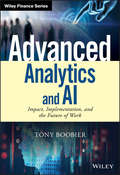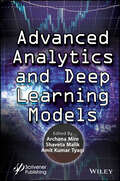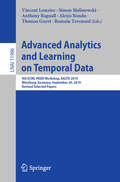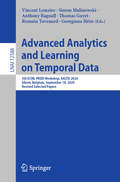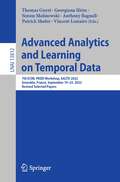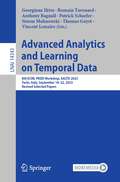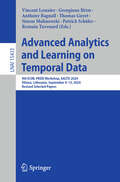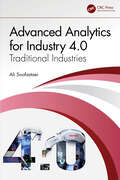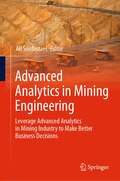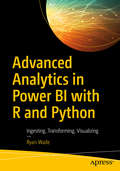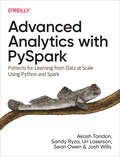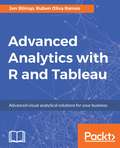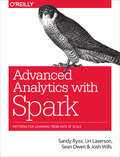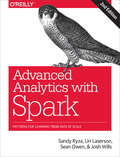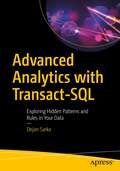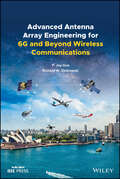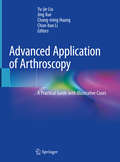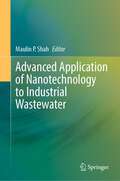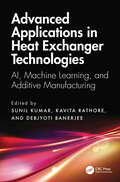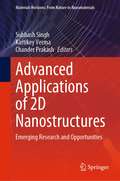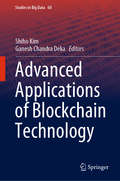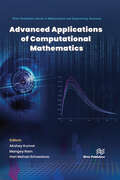- Table View
- List View
Advanced Analytics and AI: Impact, Implementation, and the Future of Work (Wiley Finance)
by Tony BoobierBe prepared for the arrival of automated decision making Once thought of as science fiction, major corporations are already beginning to use cognitive systems to assist in providing wealth advice and also in medication treatment. The use of Cognitive Analytics/Artificial Intelligence (AI) Systems is set to accelerate, with the expectation that it’ll be considered ‘mainstream’ in the next 5 – 10 years. It’ll change the way we as individuals interact with data and systems—and the way we run our businesses. Cognitive Analysis and AI prepares business users for the era of cognitive analytics / artificial intelligence. Building on established texts and commentary, it specifically prepares you in terms of expectation, impact on personal roles, and responsibilities. It focuses on the specific impact on key industries (retail, financial services, utilities and media) and also on key professions (such as accounting, operational management, supply chain and risk management). Shows you how users interact with the system in natural language Explains how cognitive analysis/AI can source ‘big data’ Provides a roadmap for implementation Gets you up to speed now before you get left behind If you’re a decision maker or budget holder within the corporate context, this invaluable book helps you gain an advantage from the deployment of cognitive analytics tools.
Advanced Analytics and Deep Learning Models (Next Generation Computing and Communication Engineering)
by Amit Kumar Tyagi Archana Mire Shaveta MalikAdvanced Analytics and Deep Learning Models The book provides readers with an in-depth understanding of concepts and technologies related to the importance of analytics and deep learning in many useful real-world applications such as e-healthcare, transportation, agriculture, stock market, etc. Advanced analytics is a mixture of machine learning, artificial intelligence, graphs, text mining, data mining, semantic analysis. It is an approach to data analysis. Beyond the traditional business intelligence, it is a semi and autonomous analysis of data by using different techniques and tools. However, deep learning and data analysis both are high centers of data science. Almost all the private and public organizations collect heavy amounts of data, i.e., domain-specific data. Many small/large companies are exploring large amounts of data for existing and future technology. Deep learning is also exploring large amounts of unsupervised data making it beneficial and effective for big data. Deep learning can be used to deal with all kinds of problems and challenges that include collecting unlabeled and uncategorized raw data, extracting complex patterns from a large amount of data, retrieving fast information, tagging data, etc. This book contains 16 chapters on artificial intelligence, machine learning, deep learning, and their uses in many useful sectors like stock market prediction, a recommendation system for better service selection, e-healthcare, telemedicine, transportation. There are also chapters on innovations and future opportunities with fog computing/cloud computing and artificial intelligence. Audience Researchers in artificial intelligence, big data, computer science, and electronic engineering, as well as industry engineers in healthcare, telemedicine, transportation, and the financial sector. The book will also be a great source for software engineers and advanced students who are beginners in the field of advanced analytics in deep learning.
Advanced Analytics and Learning on Temporal Data: 4th ECML PKDD Workshop, AALTD 2019, Würzburg, Germany, September 20, 2019, Revised Selected Papers (Lecture Notes in Computer Science #11986)
by Vincent Lemaire Simon Malinowski Anthony Bagnall Alexis Bondu Thomas Guyet Romain TavenardThis book constitutes the refereed proceedings of the 4th ECML PKDD Workshop on Advanced Analytics and Learning on Temporal Data, AALTD 2019, held in Würzburg, Germany, in September 2019. The 7 full papers presented together with 9 poster papers were carefully reviewed and selected from 31 submissions. The papers cover topics such as temporal data clustering; classification of univariate and multivariate time series; early classification of temporal data; deep learning and learning representations for temporal data; modeling temporal dependencies; advanced forecasting and prediction models; space-temporal statistical analysis; functional data analysis methods; temporal data streams; interpretable time-series analysis methods; dimensionality reduction, sparsity, algorithmic complexity and big data challenge; and bio-informatics, medical, energy consumption, on temporal data.
Advanced Analytics and Learning on Temporal Data: 5th ECML PKDD Workshop, AALTD 2020, Ghent, Belgium, September 18, 2020, Revised Selected Papers (Lecture Notes in Computer Science #12588)
by Vincent Lemaire Georgiana Ifrim Simon Malinowski Anthony Bagnall Thomas Guyet Romain TavenardThis book constitutes the refereed proceedings of the 4th ECML PKDD Workshop on Advanced Analytics and Learning on Temporal Data, AALTD 2019, held in Ghent, Belgium, in September 2020. The 15 full papers presented in this book were carefully reviewed and selected from 29 submissions. The selected papers are devoted to topics such as Temporal Data Clustering; Classification of Univariate and Multivariate Time Series; Early Classification of Temporal Data; Deep Learning and Learning Representations for Temporal Data; Modeling Temporal Dependencies; Advanced Forecasting and Prediction Models; Space-Temporal Statistical Analysis; Functional Data Analysis Methods; Temporal Data Streams; Interpretable Time-Series Analysis Methods; Dimensionality Reduction, Sparsity, Algorithmic Complexity and Big Data Challenge; and Bio-Informatics, Medical, Energy Consumption, Temporal Data.
Advanced Analytics and Learning on Temporal Data: 6th ECML PKDD Workshop, AALTD 2021, Bilbao, Spain, September 13, 2021, Revised Selected Papers (Lecture Notes in Computer Science #13114)
by Vincent Lemaire Georgiana Ifrim Simon Malinowski Anthony Bagnall Thomas Guyet Romain TavenardThis book constitutes the refereed proceedings of the 6th ECML PKDD Workshop on Advanced Analytics and Learning on Temporal Data, AALTD 2021, held during September 13-17, 2021. The workshop was planned to take place in Bilbao, Spain, but was held virtually due to the COVID-19 pandemic. The 12 full papers presented in this book were carefully reviewed and selected from 21 submissions. They focus on the following topics: Temporal Data Clustering; Classification of Univariate and Multivariate Time Series; Multivariate Time Series Co-clustering; Efficient Event Detection; Modeling Temporal Dependencies; Advanced Forecasting and Prediction Models; Cluster-based Forecasting; Explanation Methods for Time Series Classification; Multimodal Meta-Learning for Time Series Regression; and Multivariate Time Series Anomaly Detection.
Advanced Analytics and Learning on Temporal Data: 7th ECML PKDD Workshop, AALTD 2022, Grenoble, France, September 19–23, 2022, Revised Selected Papers (Lecture Notes in Computer Science #13812)
by Vincent Lemaire Georgiana Ifrim Simon Malinowski Anthony Bagnall Thomas Guyet Patrick ShaferThis book constitutes the refereed proceedings of the 7th ECML PKDD Workshop, AALTD 2022, held in Grenoble, France, during September 19–23, 2022.The 12 full papers included in this book were carefully reviewed and selected from 21 submissions. They were organized in topical sections as follows: Oral presentation and poster presentation.
Advanced Analytics and Learning on Temporal Data: 8th ECML PKDD Workshop, AALTD 2023, Turin, Italy, September 18–22, 2023, Revised Selected Papers (Lecture Notes in Computer Science #14343)
by Vincent Lemaire Georgiana Ifrim Simon Malinowski Anthony Bagnall Thomas Guyet Romain Tavenard Patrick SchaeferThis volume LNCS 14343 constitutes the refereed proceedings of the 8th ECML PKDD Workshop, AALTD 2023, in Turin, Italy, in September 2023. The 20 full papers were carefully reviewed and selected from 28 submissions. They are organized in the following topical section as follows: Machine Learning; Data Mining; Pattern Analysis; Statistics to Share their Challenges and Advances in Temporal Data Analysis.
Advanced Analytics and Learning on Temporal Data: 9th ECML PKDD Workshop, AALTD 2024, Vilnius, Lithuania, September 9–13, 2024, Revised Selected Papers (Lecture Notes in Computer Science #15433)
by Vincent Lemaire Georgiana Ifrim Simon Malinowski Anthony Bagnall Thomas Guyet Romain Tavenard Patrick SchäferThis book constitutes the refereed proceedings of the 9th ECML PKDD workshop on Advanced Analytics and Learning on Temporal Data, AALTD 2024, held in Vilnius, Lithuania, during September 9-13, 2024. The 8 full papers presented here were carefully reviewed and selected from 15 submissions. The papers focus on recent advances in Temporal Data Analysis, Metric Learning, Representation Learning, Unsupervised Feature Extraction, Clustering, and Classification.
Advanced Analytics for Industry 4.0: Traditional Industries
by Ali SoofastaeiThe evolution of modern technology has affected all the industry dimensions. Mother industries play a critical role in providing the precursor materials for other industries, and a small improvement in these can make a big change in others. This book covers the analytics revolution in Industry 4.0 for the mother industries, such as mining, oil and gas, and steel. It focuses on the use of advanced analytics and artificial intelligence to improve the business decisions aimed at increasing the quality and quantity of mother industries' products. It helps to design and implement their digital transformation strategies in these industries.Key Features: Provides a concise overview of state of the art for mother industries' executives and managers. Highlights and describes critical opportunity areas for industry operations optimization. Explains how to implement advanced data analytics through case studies and examples. Provides approaches and methods to improve data-driven decision-making. Brings experience and learning in digital transformation from adjacent sectors. This book is aimed at researchers, professionals, and graduate students in data science, manufacturing, automation, and computer engineering.
Advanced Analytics in Mining Engineering: Leverage Advanced Analytics in Mining Industry to Make Better Business Decisions
by Ali SoofastaeiIn this book, Dr. Soofastaei and his colleagues reveal how all mining managers can effectively deploy advanced analytics in their day-to-day operations- one business decision at a time.Most mining companies have a massive amount of data at their disposal. However, they cannot use the stored data in any meaningful way. The powerful new business tool-advanced analytics enables many mining companies to aggressively leverage their data in key business decisions and processes with impressive results.From statistical analysis to machine learning and artificial intelligence, the authors show how many analytical tools can improve decisions about everything in the mine value chain, from exploration to marketing.Combining the science of advanced analytics with the mining industrial business solutions, introduce the “Advanced Analytics in Mining Engineering Book” as a practical road map and tools for unleashing the potential buried in your company’s data.The book is aimed at providing mining executives, managers, and research and development teams with an understanding of the business value and applicability of different analytic approaches and helping data analytics leads by giving them a business framework in which to assess the value, cost, and risk of potential analytical solutions. In addition, the book will provide the next generation of miners – undergraduate and graduate IT and mining engineering students – with an understanding of data analytics applied to the mining industry. By providing a book with chapters structured in line with the mining value chain, we will provide a clear, enterprise-level view of where and how advanced data analytics can best be applied. This book highlights the potential to interconnect activities in the mining enterprise better. Furthermore, the book explores the opportunities for optimization and increased productivity offered by better interoperability along the mining value chain – in line with the emerging vision of creating a digital mine with much-enhanced capabilities for modeling, simulation, and the use of digital twins – in line with leading “digital” industries.
Advanced Analytics in Power BI with R and Python: Ingesting, Transforming, Visualizing
by Ryan WadeThis easy-to-follow guide provides R and Python recipes to help you learn and apply the top languages in the field of data analytics to your work in Microsoft Power BI. Data analytics expert and author Ryan Wade shows you how to use R and Python to perform tasks that are extremely hard, if not impossible, to do using native Power BI tools. For example, you will learn to score Power BI data using custom data science models and powerful models from Microsoft Cognitive Services. The R and Python languages are powerful complements to Power BI. They enable advanced data transformation techniques that are difficult to perform in Power BI in its default configuration but become easier by leveraging the capabilities of R and Python. If you are a business analyst, data analyst, or a data scientist who wants to push Power BI and transform it from being just a business intelligence tool into an advanced data analytics tool, then this is the book to help you do that. What You Will Learn Create advanced data visualizations via R using the ggplot2 package Ingest data using R and Python to overcome some limitations of Power Query Apply machine learning models to your data using R and Python without the need of Power BI premium compacity Incorporate advanced AI in Power BI without the need of Power BI premium compacity via Microsoft Cognitive Services, IBM Watson Natural Language Understanding, and pre-trained models in SQL Server Machine Learning Services Perform advanced string manipulations not otherwise possible in Power BI using R and Python Who This Book Is For Power users, data analysts, and data scientists who want to go beyond Power BI’s built-in functionality to create advanced visualizations, transform data in ways not otherwise supported, and automate data ingestion from sources such as SQL Server and Excel in a more concise way
Advanced Analytics with PySpark: Patterns for Learning from Data at Scale Using Python and Spark
by Uri Laserson Josh Wills Sandy Ryza Sean Owen Akash TandonThe amount of data being generated today is staggering and growing. Apache Spark has emerged as the de facto tool to analyze big data and is now a critical part of the data science toolbox. Updated for Spark 3.0, this practical guide brings together Spark, statistical methods, and real-world datasets to teach you how to approach analytics problems using PySpark, Spark's Python API, and other best practices in Spark programming.Data scientists Akash Tandon, Sandy Ryza, Uri Laserson, Sean Owen, and Josh Wills offer an introduction to the Spark ecosystem, then dive into patterns that apply common techniques-including classification, clustering, collaborative filtering, and anomaly detection, to fields such as genomics, security, and finance. This updated edition also covers NLP and image processing.If you have a basic understanding of machine learning and statistics and you program in Python, this book will get you started with large-scale data analysis.Familiarize yourself with Spark's programming model and ecosystemLearn general approaches in data scienceExamine complete implementations that analyze large public datasetsDiscover which machine learning tools make sense for particular problemsExplore code that can be adapted to many uses
Advanced Analytics with R and Tableau
by Jen Stirrup Ruben Oliva RamosLeverage the power of advanced analytics and predictive modeling in Tableau using the statistical powers of R About This Book • A comprehensive guide that will bring out the creativity in you to visualize the results of complex calculations using Tableau and R • Combine Tableau analytics and visualization with the power of R using this step-by-step guide • Wondering how R can be used with Tableau? This book is your one-stop solution. Who This Book Is For This book will appeal to Tableau users who want to go beyond the Tableau interface and deploy the full potential of Tableau, by using R to perform advanced analytics with Tableau. A basic familiarity with R is useful but not compulsory, as the book will start off with concrete examples of R and will move quickly into more advanced spheres of analytics using online data sources to support hands-on learning. Those R developers who want to integrate R in Tableau will also benefit from this book. What You Will Learn • Integrate Tableau's analytics with the industry-standard, statistical prowess of R. • Make R function calls in Tableau, and visualize R functions with Tableau using RServe. • Use the CRISP-DM methodology to create a roadmap for analytics investigations. • Implement various supervised and unsupervised learning algorithms in R to return values to Tableau. • Make quick, cogent, and data-driven decisions for your business using advanced analytical techniques such as forecasting, predictions, association rules, clustering, classification, and other advanced Tableau/R calculated field functions. In Detail Tableau and R offer accessible analytics by allowing a combination of easy-to-use data visualization along with industry-standard, robust statistical computation. Moving from data visualization into deeper, more advanced analytics? This book will intensify data skills for data viz-savvy users who want to move into analytics and data science in order to enhance their businesses by harnessing the analytical power of R and the stunning visualization capabilities of Tableau. Readers will come across a wide range of machine learning algorithms and learn how descriptive, prescriptive, predictive, and visually appealing analytical solutions can be designed with R and Tableau. In order to maximize learning, hands-on examples will ease the transition from being a data-savvy user to a data analyst using sound statistical tools to perform advanced analytics. By the end of this book, you will get to grips with advanced calculations in R and Tableau for analytics and prediction with the help of use cases and hands-on examples. Style and approach Tableau (uniquely) offers excellent visualization combined with advanced analytics; R is at the pinnacle of statistical computational languages. When you want to move from one view of data to another, backed up by complex computations, the combination of R and Tableau makes the perfect solution. This example-rich guide will teach you how to combine these two to perform advanced analytics by integrating Tableau with R and create beautiful data visualizations.
Advanced Analytics with Spark
by Uri Laserson Josh Wills Sandy Ryza Sean OwenIn this practical book, four Cloudera data scientists present a set of self-contained patterns for performing large-scale data analysis with Spark. The authors bring Spark, statistical methods, and real-world data sets together to teach you how to approach analytics problems by example.You'll start with an introduction to Spark and its ecosystem, and then dive into patterns that apply common techniques--classification, collaborative filtering, and anomaly detection among others--to fields such as genomics, security, and finance. If you have an entry-level understanding of machine learning and statistics, and you program in Java, Python, or Scala, you'll find these patterns useful for working on your own data applications.Patterns include:Recommending music and the Audioscrobbler data setPredicting forest cover with decision treesAnomaly detection in network traffic with K-means clusteringUnderstanding Wikipedia with Latent Semantic AnalysisAnalyzing co-occurrence networks with GraphXGeospatial and temporal data analysis on the New York City Taxi Trips dataEstimating financial risk through Monte Carlo simulationAnalyzing genomics data and the BDG projectAnalyzing neuroimaging data with PySpark and Thunder
Advanced Analytics with Spark: Patterns for Learning from Data at Scale
by Uri Laserson Josh Wills Sandy Ryza Sean OwenIn the second edition of this practical book, four Cloudera data scientists present a set of self-contained patterns for performing large-scale data analysis with Spark. The authors bring Spark, statistical methods, and real-world data sets together to teach you how to approach analytics problems by example. Updated for Spark 2.1, this edition acts as an introduction to these techniques and other best practices in Spark programming.You’ll start with an introduction to Spark and its ecosystem, and then dive into patterns that apply common techniques—including classification, clustering, collaborative filtering, and anomaly detection—to fields such as genomics, security, and finance.If you have an entry-level understanding of machine learning and statistics, and you program in Java, Python, or Scala, you’ll find the book’s patterns useful for working on your own data applications.With this book, you will:Familiarize yourself with the Spark programming modelBecome comfortable within the Spark ecosystemLearn general approaches in data scienceExamine complete implementations that analyze large public data setsDiscover which machine learning tools make sense for particular problemsAcquire code that can be adapted to many uses
Advanced Analytics with Transact-SQL: Exploring Hidden Patterns and Rules in Your Data
by Dejan SarkaLearn about business intelligence (BI) features in T-SQL and how they can help you with data science and analytics efforts without the need to bring in other languages such as R and Python. This book shows you how to compute statistical measures using your existing skills in T-SQL. You will learn how to calculate descriptive statistics, including centers, spreads, skewness, and kurtosis of distributions. You will also learn to find associations between pairs of variables, including calculating linear regression formulas and confidence levels with definite integration. No analysis is good without data quality. Advanced Analytics with Transact-SQL introduces data quality issues and shows you how to check for completeness and accuracy, and measure improvements in data quality over time. The book also explains how to optimize queries involving temporal data, such as when you search for overlapping intervals. More advanced time-oriented information in the book includes hazard and survival analysis. Forecasting with exponential moving averages and autoregression is covered as well. Every web/retail shop wants to know the products customers tend to buy together. Trying to predict the target discrete or continuous variable with few input variables is important for practically every type of business. This book helps you understand data science and the advanced algorithms use to analyze data, and terms such as data mining, machine learning, and text mining.Key to many of the solutions in this book are T-SQL window functions. Author Dejan Sarka demonstrates efficient statistical queries that are based on window functions and optimized through algorithms built using mathematical knowledge and creativity. The formulas and usage of those statistical procedures are explained so you can understand and modify the techniques presented. T-SQL is supported in SQL Server, Azure SQL Database, and in Azure Synapse Analytics. There are so many BI features in T-SQL that it might become your primary analytic database language. If you want to learn how to get information from your data with the T-SQL language that you already are familiar with, then this is the book for you. What You Will LearnDescribe distribution of variables with statistical measuresFind associations between pairs of variablesEvaluate the quality of the data you are analyzingPerform time-series analysis on your dataForecast values of a continuous variablePerform market-basket analysis to predict customer purchasing patternsPredict target variable outcomes from one or more input variablesCategorize passages of text by extracting and analyzing keywordsWho This Book Is ForDatabase developers and database administrators who want to translate their T-SQL skills into the world of business intelligence (BI) and data science. For readers who want to analyze large amounts of data efficiently by using their existing knowledge of T-SQL and Microsoft’s various database platforms such as SQL Server and Azure SQL Database. Also for readers who want to improve their querying by learning new and original optimization techniques.
Advanced Antenna Array Engineering for 6G and Beyond Wireless Communications
by Richard W. Ziolkowski Yingjie Jay GuoAdvanced Antenna Array Engineering for 6G and Beyond Wireless Communications Reviews advances in the design and deployment of antenna arrays for future generations of wireless communication systems, offering new solutions for the telecommunications industry Advanced Antenna Array Engineering for 6G and Beyond Wireless Communications addresses the challenges in designing and deploying antennas and antenna arrays which deliver 6G and beyond performance with high energy efficiency and possess the capability of being immune to interference caused by different systems mounted on the same platforms. This timely and authoritative volume presents innovative solutions for developing integrated communications networks of high-gain, individually-scannable, multi-beam antennas that are reconfigurable and conformable to all platforms, thus enabling the evolving integrated land, air and space communications networks. The text begins with an up-to-date discussion of the engineering issues facing future wireless communications systems, followed by a detailed discussion of different beamforming networks for multi-beam antennas. Subsequent chapters address problems of 4G/5G antenna collocation, discuss differentially-fed antenna arrays, explore conformal transmit arrays for airborne platforms, and present latest results on fixed frequency beam scanning leaky wave antennas as well as various analogue beam synthesizing strategies. Based primarily on the authors’ extensive work in the field, including original research never before published, this important new volume: Reviews multi-beam feed networks, array decoupling and de-scattering methods Provides a systematic study on differentially fed antenna arrays that are resistant to interference caused by future multifunctional/multi-generation systems Features previously unpublished material on conformal transmit arrays based on Huygen’s metasufaces and reconfigurable leaky wave antennas Includes novel algorithms for synthesizing and optimizing thinned massive arrays, conformal arrays, frequency invariant arrays, and other future arrays Advanced Antenna Array Engineering for 6G and Beyond Wireless Communications is an invaluable resource for antenna engineers and researchers, as well as graduate and senior undergraduate students in the field.
Advanced Antimicrobial Materials and Applications (Environmental and Microbial Biotechnology)
by Inamuddin Ram Prasad Mohd Imran AhamedSurface bio-contamination has become a severe problem that contributes to outbreaks of community acquired and nosocomial infections through contiguous fomite transmission of diseases. Every year, thousands of patients die due to nosocomial infections by pathogens. It is therefore essential to develop novel strategies to prevent or improve the treatment of biomaterial concomitant infections. The concept of antimicrobial materials is becoming increasingly important not only in the hospital and healthcare environments, but also for laboratories, home appliances, and certain industrial applications. Materials are now being developed to prevent the buildup, spread and transfer of harmful microbes, and to dynamically deactivate them. Drawing on research and examples from around the world, this book highlights the latest advances in, and applications of, antibacterial biomaterials for biomedical devices, and focuses on metals with antibacterial coatings/surfaces, antibacterial stainless steels and other commonly used antibacterial materials. It also discusses the role of innovative approaches and provides a comprehensive overview of cutting-edge research on the processing, properties and technologies involved in the development of antimicrobial applications. Given its scope, the book will be of interest to researchers and policymakers, as well as undergraduate and graduate students of biochemistry, microbiology, and environmental chemistry
Advanced Application of Arthroscopy: A Practical Guide with Illustrative Cases
by Chang-Ming Huang Yu-Jie Liu Jing Xue Chun-Bao LiThis book provides arthroscopy techniques and applications to clinical practitioners, including sports medicine therapeutics, orthopaedic surgeons, specialist training candidates, rehabilitation clinicians. It also includes small incisions per minimally invasive surgery using a camera mounted on a thin tube to visualize, repair and reconstruct joint-associated structures. Arthroscopy technique as a minimally invasive surgical method, in Orthopeadics is not only for the treatment of intra-articular diseases but also an advanced conception for treatment of extra-articular diseases and peri-articular fractures. After performing years of arthroscopy, authors intend to provide an elite technique demonstration of each procedure, including indications, technique, complications, and results. There are three main parts of the book, including the extra-articular application of arthroscopy techniques, arthroscopic minimally invasive techniques for the treatment of intra-articular fractures, and Innovative technology for repair and reconstruction of bone and joint injuries. Key technical points and experience of arthroscopic repair of joint injuries, dislocation of joints, fixation of the intra-articular fractures, ligament release for limbs are illustrated. Special situations such as congenital torticollis, deltoid contracture, gluteal muscle contracture, bone grafting, removal of locking plate and screw and benign tumors treatment are also included.
Advanced Application of Nanotechnology to Industrial Wastewater
by Maulin P. ShahThis book discusses new and innovative trends and techniques in the application of nanotechnology to industrial wastewater treatment both at a laboratory scale and an industry scale, including treatment, remediation, sensing and pollution prevention. The book also explores unique physicochemical and surface properties of nanoparticles; it highlights advantages they provide for engineering applications. Each chapter covers a different nanotechnology-based approach and examines basic principles, practical applications, recent breakthroughs and associated limitations. Nanotechnology applications to wastewater research have significant impact in maintaining the long-term quality, availability and viability of water. Regardless of the origin—for example, municipal or industrial wastewater—the remediation nanotechnology allows water to be recycled and desalinized in addition to simultaneously detecting biological and chemical contamination. The book describes a broad area of nanotechnology and water research where membrane processes (nanofiltration, ultrafiltration, reverse osmosis and nanoreactive membranes) are considered key components of advanced water purification and desalination technologies that remove, reduce or neutralize water contaminants. Various nanoparticles and nanomaterials that could be used in water remediation (zeolites, carbon nanotubes, self-assembled monolayers on mesoporous supports, biopolymers, single-enzyme nanoparticles, zero-valent iron nanoparticles, bimetallic iron nanoparticles and nanoscale semiconductor photocatalysts) are also discussed. This book is beneficial for students and academicians to understand the recent research advancements in the field.
Advanced Applications in Acoustics, Noise and Vibration
by John Walker Frank FahyAdvanced Applications in Acoustics, Noise and Vibration provides comprehensive and up-to-date overviews of knowledge, applications and research activities in a range of topics that are of current interest in the practice of engineering acoustics and vibration technology. The thirteen chapters are grouped into four parts: signal processing, acoustic modelling, environmental and industrial acoustics, and vibration.Following on from its companion volume Fundamentals of Noise and Vibration this book is based partly on material covered in a selection of elective modules in the second semester of the Masters programme in 'Sound and Vibration Studies' of the Institute of Sound and Vibration Research at the University of Southampton, UK and partly on material presented in the annual ISVR short course 'Advanced Course in Acoustics, Noise and Vibration'.
Advanced Applications in Heat Exchanger Technologies: AI, Machine Learning, and Additive Manufacturing
by Sunil Kumar, Kavita Rathore, and Debjyoti BanerjeeAdvanced Applications in Heat Exchanger Technologies presents the most recent developments in enhancing heat exchanger performance, reliability, and resilience, including the implementation of Artificial Intelligence, Machine Learning, and Additive Manufacturing.Covering the essential parts of many commercial endeavors, ranging from aerospace to marine applications to oil-and-gas, the book discusses various heat exchanger types and interdisciplinary industry applications. It encompasses several different techniques, such as nanofluids, microchannel heat exchangers, computer modeling, advanced manufacturing, and optimization. The book addresses real-world concerns that impact long-term heat exchanger performance and dependability such as fouling, corrosion prevention, and maintenance measures.This book is intended for researchers and graduate students who are interested in heat exchangers R&D and the diverse range of industrial applications of heat exchanger technologies in contemporary practice.
Advanced Applications of 2D Nanostructures: Emerging Research and Opportunities (Materials Horizons: From Nature to Nanomaterials)
by Kartikey Verma Chander Prakash Subhash SinghThis book focuses on both recent advances and the applications of two-dimensional (2D) nanomaterials in different fields. This book encapsulates all the aspects related to 2D nanomaterials and their applications. It provides scientific and technological insights on novel routes of design and fabrication of few layered nanostructures and their hetero structures based on a variety of 2-D layered materials. It also covers a wide range of industrial applications of 2D nanomaterials. It emphasizes on the detailing of the various characterization techniques used. The book will be a valuable reference for beginners, researchers, and professionals interested in nano-materials and allied fields.
Advanced Applications of Blockchain Technology (Studies in Big Data #60)
by Ganesh Chandra Deka Shiho KimThis contributed volume discusses diverse topics to demystify the rapidly emerging and evolving blockchain technology, the emergence of integrated platforms and hosted third-party tools, and the development of decentralized applications for various business domains. It presents various applications that are helpful for research scholars and scientists who are working toward identifying and pinpointing the potential of as well as the hindrances to this technology.
Advanced Applications of Computational Mathematics: Theoretical Advances And Advanced Applications (De Gruyter Series On The Applications Of Mathematics In Engineering And Information Sciences Ser. #3)
by Mangey Ram Akshay Kumar Hari Mohan SrivastavaThis book “Advanced Applications of Computational Mathematics” covers multidisciplinary studies containing advanced research in the field of computational and applied mathematics. The book includes research methodology, techniques, applications, and algorithms. The book will be very useful to advanced students, researchers and practitioners who are involved in the areas of computational and applied mathematics and engineering.
